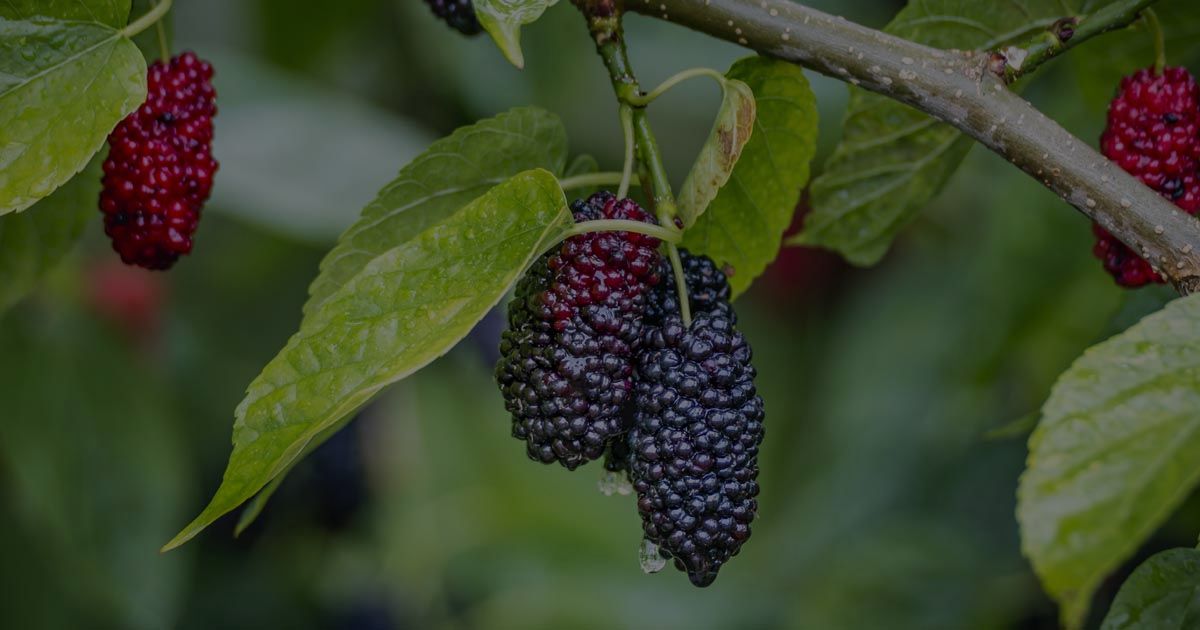
The Mulberry tree (Morus spp.) is one of the easiest fruiting plants you can grow in your garden. However, these plants have a bad reputation: They produce plenty of flavourful fruits that birds scatter and ruin the sidewalks. Moreover, many gardeners avoid growing them because they are considered weeds.
However, the ability to grow independently makes these plants perfect for beginners. The delicious fruits are a plus. They can be eaten raw or made into jams, jellies, or wines. Harvesting and stocking the fruits is difficult, so growing these plants is a great option, as mulberry tree care is also easy.
In this guide, we have covered everything you need to know about mulberry tree care and how you can grow these plants in your fruit garden easily.
What Is The Mulberry Tree?

There are many varieties of the mulberry tree. However, some of the most commonly grown are – Black, Red, and White mulberry trees. These plants can reach up to 50 feet in height and, depending on the variety, produce dark, glossy leaves along with small clusters of reddish-black fruits.
Mulberry trees are also loved by wildlife and have been used by humans for thousands of years. Moreover, they require minimal care, one of their most popular qualities. Moreover, mulberry trees are self-pollinating plants and require no partner; however, a partner can improve the overall yield.
Mulberry fruits are produced in summer, and these plants produce flowers in spring. The fruits have a distinct flavor that is often compared to a mix of blackberries, grapefruits, and loganberries. These fruits can be consumed raw, fresh, or dried, making them extremely versatile.
Moreover, mulberry fruits are a great complement to any well-balanced diet because they are a great source of protein, dietary fiber, lipids, and antioxidants. Vitamin C, a vital nutrient that promotes collagen synthesis and immunological function, is remarkably abundant in mulberries. In addition, they are a good source of iron, potassium, magnesium, manganese, zeaxanthin, riboflavin, resveratrol, and other vital minerals that support general health and well-being.
Types Of Mulberry Trees
Here are some of the famous mulberry trees that can be grown in your garden –
- Red Mulberry Tree (Morus Rubra): The fruits of this variety start green and the trunk turns reddish-purple when ripe. Moreover, the leaves are twice as big as the white mulberry and have hairy undersides.
- White Mulberry Tree (Morus Alba): The blackberry-shaped fruit of this tree has its distinctive feature. This mulberry tree variety is native to China and is grown widely in North America.
- Black Mulberry Tree (Morus nigra): The almost black, large berries of this mulberry tree variety is a delicacy. Native to Asia these plants aren’t commonly found everywhere.
- Texas Mulberry Tree (Morus centifolia): This shrub-like variety of mulberry is native to southwest America and features black, red, or purple fruits.
Mulberry Tree Care

Even though caring for mulberry trees is very easy, there are some things that every plant parent must know before growing them.
Water
These drought-tolerant plants require only modest irrigation. They can withstand a certain amount of drought, but too much dryness is crucial since it can cause wilting, stunted development, and low fruit yield.
The age of the tree, the kind of soil, and the environment will all affect how often and how much watering is needed. To aid in the establishment of their root system, newly planted mulberry trees should generally receive one or two thorough waterings per week throughout the first growth season. Although they may benefit from a deep soaking every two to three weeks during the growing season, mature trees need less regular irrigation.
Light
Both full sun and partial shade are suitable for mulberry tree care. These trees are a wonderful addition to sunny, well-lit spaces because they need a lot of sunlight to flourish. A robust and bountiful crop usually requires at least 6 to 8 hours of direct sunlight per day. They can withstand a certain amount of shade, but too little light can hinder their growth and fruit output.
It’s crucial to remember that the type of mulberry tree you have will affect the amount of sunlight and how long it lasts. While some types, like the black mulberry, need full light to provide their delicious and flavorful fruit, others, like the white mulberry, can withstand some shade.
Temperature & Humidity
In general, mulberry trees are resilient and tolerant of a variety of climates. They do, however, need a certain temperature to thrive and produce fruit at their best. With a desired temperature range of 70-85°F (21-29°C) during the day and 45-65°F (7-18°C) at night, mulberry trees thrive in a warm, temperate region. In the winter, they can withstand temperatures as low as 20°F (-7°C), however continuous exposure to freezing conditions may cause damage or dieback.
For better mulberry tree care avoid stress and sunburn, it is essential to make sure the tree has enough shade and moisture in regions with hot summers. Winter dormancy also assists mulberry trees by encouraging robust growth and fruit production the next season.
Mulberry trees can adapt to both dry and humid conditions and often handle a wide range of humidity levels. They do, however, require moderate humidity—that is, neither too wet nor too dry. Maintaining adequate air circulation around the tree is essential in high-humidity areas to avoid fungal plant diseases like leaf spots and powdery mildew. This can be accomplished by avoiding crowded planting conditions and placing your tree in an open, well-ventilated place.
In dry locations, for better mulberry tree care, try misting or spraying to raise humidity levels and stop leaf wilting. Additionally, the effects of the dry air can be lessened by regularly watering the soil to maintain appropriate moisture levels.
Soil
Mulberry trees favor well-draining soil that is high in nutrients and organic matter. Although they can thrive in a variety of soil types, they prefer slightly acidic to neutral soils with a pH between 6.0 and 7.0.
Before planting a mulberry tree, make sure the soil is ready by clearing away any trash or weeds and adding organic materials like compost or well-rotted manure. This will support better mulberry tree care, healthy root development, enhanced nutrient availability, and improved soil structure.
Additionally, mulberry trees need a lot of room to spread their roots because they have a deep root system. To minimize root rot, it’s crucial to avoid planting trees in soil that drains poorly.
Fertilizer
For mulberry trees to develop healthily and produce fruit, fertilizing must be applied regularly. A balanced fertilizer that offers equal levels of potassium, phosphorus, and nitrogen is usually beneficial to them.
Mulberry trees should ideally be fertilized in early spring when new growth is starting. Fertilize again in early summer, once the fruit has set. These trees benefit greatly from slow-release fertilizers since they gradually give nutrients.
Mulberry trees can also benefit from organic fertilizers like compost, manure, or bone meal in addition to NPK fertilizers. These can be worked into the soil surrounding the tree’s base or applied as a top dressing.
Pruning
Mulberry trees don’t need much pruning; in fact, too much pruning might stress them out and lower their fruit yield. Mulberry trees are best pruned when they are still dormant, which is in late winter or early spring. During this time, you can cut off any branches that are infected, dead, or damaged.
Winter is also a good time to trim any water sprouts or suckers from the tree’s base. Fruit output may be decreased if the tree is pruned too much from the top. All things considered, you can support the preservation of your mulberry tree’s health and yield by trimming sparingly and carefully.
Common Problems With The Mulberry Tree
Here are some common problems with the mulberry tree –
- Pests – Mulberries may have to deal with several pests, including scale, whiteflies, and mealybugs. The good news is that mature mulberries are resistant to these pests and do not suffer much harm, which is fortunate because it can be difficult to cure huge trees.
- Toxicity – Because the milky sap of mulberry trees contains latex, all portions of the tree, except for the ripe berries, can be toxic to pets and humans. You might experience nausea, nervous system excitement, or (in extreme situations) hallucinations if you eat an unripe fruit.
- Messy Fruits – Because of its falling fruit stains pavement and even automobiles, this tree’s fruiting and prolific kinds are frequently seen as a nuisance. Plant a sterile cultivar that doesn’t bear fruit to avoid this. Try planting a mulberry tree in a patio space where the fruit won’t make a mess if you want it to bear fruit.
Conclusion
Mulberry tree care is very easy and growing these plants can be beneficial for the environment and your garden. Mulberry trees come in many varieties and produce edible delicious fruits. So make sure to grow these plants. Use the Plantora app to learn more about unique plants and their care requirements.
Raghav is a talented content writer with a passion to create informative and interesting articles. With a degree in English Literature, Raghav possesses an inquisitive mind and a thirst for learning. Raghav is a fact enthusiast who loves to unearth fascinating facts from a wide range of subjects. He firmly believes that learning is a lifelong journey and he is constantly seeking opportunities to increase his knowledge and discover new facts. So make sure to check out Raghav’s work for a wonderful reading.







